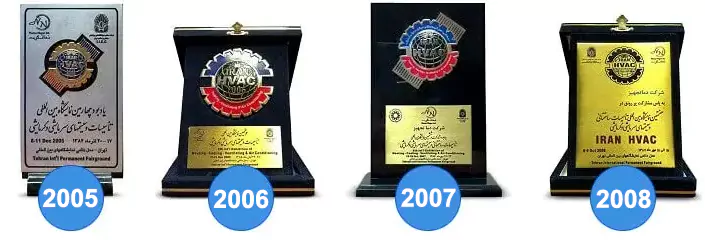Underfloor Heating
Underfloor heating is one of the most common heating systems for villas and buildings in humid areas by today's standards. The following content provides all the information, implementation methods, how to check, and the best purchase price for all types of underfloor heating equipment.
Underfloor Heating Expert Buying Guide and Price List
Archaeological excavations in Asia and the Aleutian Islands in Alaska show that floor heating dates back to the Neolithic period. At that time, people would light a fire under their houses, and through stone piping, they would direct the smoke from the fire to the outside and use the heat for the indoor environment, which was the beginning of modern underfloor heating.
With today’s technology, a system is designed consisting of pipes filled with liquid or special cables for electric current to achieve an optimal method for heating the environment and saving costs, which is getting more and more popular.
The greenhouse gases and excessive use of fossil fuels have a huge effect on global warming, and experts and researchers in all fields are trying to prevent/reduce it. Underfloor heating is preferred over other common heating systems such as heating radiators or fan coils in some operations, and in comparison to them, the uniform and pleasant distribution of underfloor heating can save up to 30% of energy.

Types of Underfloor Heating
Underfloor heating is classified into different types based on piping structure, underfloor heating with the continuous coil, underfloor heating with collector, and combined underfloor heating, each of which contains unique advantages:
Review, Selection, and Pricing of HVAC Equipment
Continuous Coil Underfloor Heating
This type uses a continuous coil arrangement. In this method, the network pressure drop is relatively high, but they are less expensive than other types.
Collector Underfloor Heating
Unlike continuous coil underfloor heating, collector underfloor heating has a lower pressure drop, but the problem is the possibility of creating a fluid flow in all parts.
Advantages of Underfloor Heating
Among the advantages of underfloor heating compared to other heating systems, the following can be mentioned:
- Longevity
- Reducing fuel consumption
- Creating uniform and pleasant heat
- Decoration friendly
- Use of heat and sound insulation foam
- Eliminating the depreciation cost of the radiator and valve
Underfloor Heating Temperature Range
Unlike other common heating systems such as radiators or fan coils, underfloor heating is a low-temperature system, which means in the relevant temperature standard the 35 to 45 degrees Celsius water should flow in the pipes, and if this temperature range is not observed, the environmental conditions can become either too cold or too hot.
Therefore, it is very important to provide hot water at a high temperature (about 75 degrees Celsius) for sanitary consumption (by secondary heat exchangers), radiators in parts of the building, and towel warmers in bathrooms and keeping the temperature of the running water in the underfloor heating in the approximate range of 40 degrees Celsius at the same time using special technical methods.
Heat Production Methods in Underfloor Heating
In the underfloor heating, heat is produced in two ways:
Hot Water (Wet Method)
Hot water underfloor heating is older as resistant pipes are built into the floor either during the construction stage of the house or later during the repairs and these pipes are connected to the hot water generator that circulates the hot water through pipes.
Electric Current (Dry Method)
In this method, the elements (electric cables) are connected to a plastic net spread like a carpet and then covered with the surface flooring. This type of underfloor heating is used in residential buildings, offices, factories, stadiums, and poultry farms. Electric underfloor heating is also used to melt ice and snow on the roads and football fields.
In both methods, the amount of heat produced is controlled by a thermostat, which is usually installed on the wall to adjust the heat in the desired location.
Underfloor Heating System Compared to Old Heating Systems
Heating through a radiator may seem like a common method, but with the rapid development of technology and the invention of different methods, this method is considered a traditional method for the heating system. In this section, we compare the old heating systems with the underfloor heating in several ways:
The Heating
In underfloor heating, heat is present in all environments and originates from the floor of the building; In a radiator heating system, the heat flows around the radiators and usually does not heat the entire environment. In the radiator heating system, the heat goes up due to the lightness of the hot air and the cold air stays down due to the convection current.
Air Quality
In the radiator heating system, the hot air produced circulates, and this air circulation causes the dust in the environment to move around, which can be a reason for reducing the quality of the air, which in underfloor heating happens much less often.
Interior Design
With radiators, to install them in different places of the project, radiators with different numbers of fins are usually installed by calculating the dimension of the environment. These radiators waste part of the space and this issue creates limitations for designers and interior architecture. This problem does not exist in the underfloor heating.
Installation
The installation and operation of the radiator is difficult and troublesome, but underfloor heating is a connected system of electrical wiring or water pipes, foam, and plastic mesh, that spreads like a carpet.

Can the Underfloor Heating Be Used in Open Spaces?
The answer to this question can be shown with practical examples in cold countries. These countries use underfloor heating in football stadiums or any outdoor grass sports fields to prevent the fields from freezing during games and training.
Underfloor heating system to melt heavy snow that disrupts the movement of people and cars. In open parking lots and roads where the risk of traffic accidents is high due to heavy snowfall, it is possible to increase the safety of those roads by using this method in winter.
Underfloor Heating Installation and Implementation Tips
In general, before the implementation of the underfloor heating, all operational and calculation plans should be prepared and implemented according to that system. Otherwise, there will be problems such as high fuel consumption and uneven heating. The first step is to determine the location of the collector box and install it.
The collector box should have convenient access to the heat source as much as possible. Consider two-round collectors with the appropriate size, where all the information in the calculation map must be present, in the collector box, and divide it into the desired number of spaces for that branch.
During piping, it should be noted that the pipes do not cross each other or under the walls. If this happens, the pipes under pressure will burst and damage the entire system. The surrounding walls are insulated between 6 and 10 cm, and then the floor is insulated.
After the completion of the insulation process, the piping is done, and again according to the calculations, the distances between the pipes should be taken into account at the time of implementation.
After the piping stage, the heating system must be fully implemented and checked again with all the drawings, which in case of error, it is possible to change it before concreting.
After the implementation of the underfloor heating and sealing test pipes on the floor, the concreting stage begins, and the floor construction should not be performed until the concrete is completely dry. After the drying of the concrete and the implementation of the floor, the implementation and installation of the underfloor heating is completed.

Underfloor Heating Installation Steps
During the installation and implementation stages, two points should be paid attention to. An air intake system should be installed on the water return pipes. The pipes must be bent according to the standard in the bending parts in the piping network plan protected inside the casing and must be under pressure for 48 hours before flooring.
Disadvantages of Underfloor Heating Systems
The large size of the used pipes, the impossibility of making changes to the floor of the building, and the need for more time to heat the environment are some of the disadvantages of underfloor heating systems.
Buying an Underfloor Heating
To choose and buy an underfloor heating easily, you must first determine the type, brand of material used, and installation location. On the website of DamaTajhiz HVAC technical information about all types of underfloor heating, from known brands with original warranties has been presented, so that you can enjoy the good feeling of optimal and smart shopping.
Note: One of the problems that can be seen in some houses (usually Iranian houses) is the use of ceramic and stone on the floor, which causes the environment to lose more heat. This is why the residents of these houses use floor coverings or footwear at home; in this situation, underfloor heating is a very suitable option.
Underfloor Heating System Price
According to the prices presented on the DamaTajhiz HVAC website, you can check the types of underfloor heating for your project.
It should be noted that the pricing of the underfloor heating systems provided on the DamaTajhiz HVAC website is up-to-date, and discounts will be considered for wholesale purchases.
"Knowledge Fuels Better Choices"
Registered Trademark and Stewardship Business Licenses Issued by the Union of Virtual Business Association and the HVAC Equipment Industry.
DamaTajhiz HVAC Participation at International HVAC and Construction Facilities Exhibitions Demonstrates its Global Reach and Commitment to the Industry.
We Look Forward to Your Call and the Opportunity to Meet With You
SHARE THIS CONTENT TO SPREAD THE KNOWLEDGE
| |
Head Office: No. 463,Talebian Alley,Taleghani St.Tehran,Iran


DamaTajhiz has provided the opportunity to sell and ship specialized HVAC equipment for applicants in the following countries as the first and the most popular online store for selling HVAC equipment (Heating , Ventilation , Cooling , Air conditioning) in the Middle East : Afghanistan – Tajikistan - Uzbekistan – Turkmenistan – Azerbaijan – Armenia – Georgia – Turkey – Iraq – Syria – Jordan – Kuwait – Emirates – Qatar – Oman.



